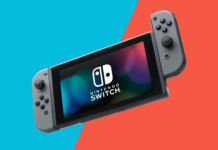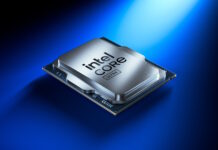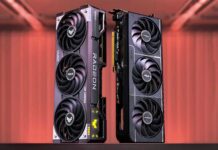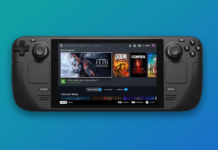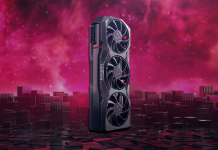We have two cards in the Testlab today: PowerColor Radeon 9600 XT Bravo Edition and XFX GeForce FX 5900 XT. The first card is a overclocked Radeon 9600 XT and the nVidia-based 5900 XT is the challenger of today. Radeon 9600 XT is known to most of you since a long time. GeForce FX 5900 XT got, strangely, a rather silent launch. Despite that nVidia did not give it much attention the reactions have been good and is often called “the new Ti4200”. For you who have lived under a stone for the last years: Ti4200 is one of the most popular cards ever, mostly thanks to its great price/performance ratio.
It has become
time for the first GFX review of the year at NH. Last year we more or less
reviewed
a major part of the new graphics cards (on the Swedish market) but there
are
still more manufacturers and models to examine before CeBit where ATi and
nVidia probably will launch new products.
We have two
cards
in the Testlab today: PowerColor Radeon 9600 XT Bravo Edition and XFX GeForce
FX 5900 XT. The first card is a overclocked Radeon 9600 XT and the nVidia-based
5900 XT is the challenger of today. Radeon 9600 XT is known to most of you
since a long time. GeForce FX 5900 XT got, strangely, a rather silent launch.
Despite that nVidia did not give it much attention the reactions have been
good and is often called "the new Ti4200". For you who have lived
under a stone for the last years: Ti4200 is one of the most
popular cards ever, mostly thanks to its great price/performance ratio.
The goal of today’s
article is simply to examine the best graphics card of these two.
Pine-owned XFX
is a new brand for us at NordicHardware (meaning that we haven’t tested
their products before). Here in Sweden it’s not that common yet but we’ve
begun to see their products in stores. Therefore it’s rather appropriate
to take a look at them now. You can see the box below, a pretty cool one.
On the back you can see the card itself through a layer of thin plastic.
XFX GeForce FX 5900 XT

|
Chipset: |
NV35
|
Manufacturing process: |
0.15-micron
|
Transistors: |
~130 mil.
|
GPU-clock: |
390 MHz
|
Memory clock / bandwidth: |
|
Pixel Shader: |
2.0
|
Vertex Shader: |
2.0
|
Pixel Pipelines/Pixel Fillrate: |
4 / 1560 MP/s
|
TMU’s/Texel Fillrate: |
|
RAMDAC: |
400 MHz
|
Memory amount: |
128 MB
|
Type of memory and interface: |
256-bit, DDR
|
In- and outputs: |
VGA, DVI, S-Video
|
Extra accessories: |
S-Video-composite-adapter, DVI-VGA-adapter
|
Software: |
5 Game Demos CD, 6 Game Demos CD
|
Retail software: |
Comanche 4, Ghost Recon, Moto GP2, Racing Simulator 3
|
Estimate price : |
–
|
FX 5900 XT is based on the old well-known GeForce FX 5900 Ultra and GeForce FX 5900. The only practical difference is that the XT-versions (sometimes called LX or SE and so on) have a bit slower memories. We’ve seen a lot of different variants of 5900 XT. The standard set by nVidia is set at 390/700 Mhz. Though we’ve seen some cards with for example 400/700 and 390/710 and so on. XFX’s card has 100 Mhz faster memory than the standard which of course is nice to see. We had a hard time finding this card in a swedish store thus we have no price tag on this card. Other 5900 XT-cards weighs in at about 2000 SEK and we assume that this card will be in that level.

Front |
|

Back |
|
We have a standard-PCB for 5900, in black. No oddities here. Since the card "only" has 128 MB memory there are no memory pods on the back of the card.

Cooling |
|

In- and outputs |
|
The cooling
is genuine with big heatsinks both for GPU and memory. The audio levels
are ok but could have been a bit quieter. The thing I personally found
to be pretty unnecessary was that they’ve done their bracket "dual-slot",
which means that the card uses the PCI-slot below the AGP-slot. This is completely
unnecessary since the cooling of the card is not that big.

Accessories |
|
The accessory package looks nice. Two quick manuals, cables and adapters including software and games. Among the games we find Comanche 4, Ghost Recon, Moto GP2 and Racing Simulator 3 and also two CDs with game demos with 5 and 6 demos. More than acceptable. The only thing "missing" is some kind of DVD-software
PowerColor has a rather "calm" box compared to XFX. On the upper right they proudly present a free game in form of Tomb Raider. Half Life 2-cupoon have had to move over for the well equipped action heroine. hardly a good switch in my opinion but taste varies from person to person.
PowerColor Radeon 9600 XT Bravo

|
Chip: |
RV360 |
Manufacturing process : |
0.13-micron, Low-K |
Transistors: |
~65 mil. |
GPU frequency: |
500 MHz |
Memory frequency/bandwidth: |
|
Pixel Shader: |
2.0
|
Vertex Shader: |
2.0
|
Pixel
Pipelines/Pixel Fillrate: |
4 / 2000 MP/s
|
TMU’s/Texel Fillrate: |
1 / 2000 MT/s
|
RAMDAC: |
400 MHz |
Memory: |
128 MB |
Type
of memory and interface: |
128-bit, DDR |
In-
and out-connections: |
DVI-I, VGA, S-Video (Composite and S-Video In and Out) |
Extra
accessories: |
ViVo-dongle, 2 st S-Video-cables, S-Video-Composite-adapter, DVI-VGA-adapter, Composite-cable |
Software: |
6 Game Demos CD |
Retail software: |
Tomb Raider, Big Mutha Truckers, PowerDirector 2 ME, WinDVD 4 |
Approximate price: |
|
PowerColor’s card has, just as XFX, faster memories than standard. It has also been equipped with ViVo (Video In/Video Out) which is a nice addition. Availability is poor but on the other hand the card is available at renowned retailer Komplett making it far from hard to get your hands on. The price lies at 1900 SEK which will be 100-200 SEK less then you have to pay for the 5900 XT.

Front |
|

Back |
|
Classic ATi-red PCB with a not so classical PowerColor-fan. On the right side, on the back of the card, we find the Rage Theatre-chip (the large "lonesome" chip). This chip handles Video In-functions.

Cooling |
|

In- and outputs |
|
The cooling
looks a bit more powerful then ATi’s reference cooler. It’s nice to see
that the cooler covers the memory, it’s less nice that it has no similar
cooling for the memory on the back.
When it comes
to in and outputs this card has an extra feature consisting out
of Video In. Thus, except the outputs S-Video (Composite with adapter),
VGA and DVI, we can capture video with both composite- and S-video-signals.

Accessories |
|
PowerColor offers
less games (and game demos too) then XFX. On the other hand it has a "lite retail"-version of Tomb Raider (summarized we can say that the game comes in a small case, no manual though). Mainly it’s the Video In-software and WinDVD that finally makes these two packages equal.
The testsystem
has remained unchanged since last time and still keeps up with the times,
although we have given Athlon 64 a glance or two at, for example maybe
when when we will test NV40 and R420. The reason you are going to want
fastest possible system testsystem is simply to make graphics the bottleneck.
It’s simply the best way we can give you fairest possible overview of how
a graphics card affects performance relative to other graphics cards.
|
Testsystem
|
|
|
| Processor: |
AMD Athlon XP 3200+ (400) Mhz
|
| Mainboard: |
ABIT AN7 uGuru
(nForce2 400 Ultra) |
| RAM: |
768 MB DDR400 @ 2-5-2-2 Timings:
3x 256 MB Corsair TWINX512-3200LL DDR-SDRAM |
|
Graphics cards :
|
Reviewed cards:
XFX GeForce FX 5900 XT (128 MB, 400/700)
PowerColor Radeon 9600 XT Bravo (128 MB, 500/675)
Reference cards :
GeForce FX 5700 Ultra (128 MB, 475/900)
Radeon 9800 (128 MB, 325/580)
|
|
HDD:
|
37 GB Western Digital Raptor 10 000 RPM (SATA, 8 MB cache)
|
|
Sound card :
|
Creative
Soundblaster Audigy 2 ZS Platinum Pro |
| PSU: |
Antec 430W
|
|
Ethernet:
|
3Com 10/100
|
|
|
| Operating system : |
Windows XP Professional (Service Pack 1 + updates)
|
| Graphics drivers: |
nVidia: Forceware 53.03
ATi: Catalyst 4.2 |
| Other drivers: |
nVidia ForceWare UDA Chipset Drivers v3.13
|
|
Benchmarking software:
|
Unreal Tournament 2003 (v2225)
Quake 3: Arena (v1.32)
Tomb Raider: Angel of Darkness (v.49)
Star Wars Jedi Knight: Jedi Academy (v1.1)
Battlefield 1942: Secret Weapons of World War II (demo "1.0")
Comanche 4 (demo "1.0")
WarCraft 3: Reign of Chaos (demo "1.0")
Counter-Strike (v1.6)
Mafia: City of Lost Heaven (v1.1)
Halo (v1.04)
Max Payne 2: The Fall of Max Payne (v1.01)
|
We have chosen to have two reference products today. The two cards are GeForce FX5700 Ultra and Radeon 9800 which both costs about as much the two reviewed cards.
in the review
you will read some expressions and shortenings, if they aren’t known
for you we recommend reading the list below. In the same list we have
some expressions that is used specific in this review (they are not generally
accepted).
- AA, FSAA (Full
Scene Anti Aliasing) – Edge smoothing (reduces edgy lines in 3D-graphics),
all modern graphics cards should be able to do this in some form. AA
can be applied in varying"strength" 2, 4, 6 x etc. The more the
better.
- AF, Aniso (Anisotropic
Filtering) – Anisotropic texture filtering (increases sharpness in
textures/surfaces when using 3D-graphics), all modern graphics cards
should also be able to use AF. Just as AA you can use varying"strength", the more the better.
- App (Application
Preference) – If something is marked with this suffix it means we have
let the control over AF to the game instead of making the setting on
the graphics cards control panel.
- Trilinear and bilinear filtering –
two different types of texture filtering that is either used by themselves
or in combination with Anisotropic filtering. The most high quality
combination is is Trilinear and Anisotropic filtering. Nowadays trilinear
filtering is the standard in all games released and should be looked
at as a minimum for acceptable quality with today’s standards.
- Aliasing –
Graphical errors caused by for example not enough information/precision.
Often it’s "dancing" pixels either on edges or inside textures. by using AA and AF you can reduce aliasing.
If you are
uncertain about anything of the above you are welcome to mail me your
question through the address you can find in the head of the review.
(Please remember though that we are no voluntary support service, for
question regarding support we recommend trying out our forum or the retailer
where you bought your products.)
There’s not really much more to say, basically both cards uses old technology which most people are have seen before and we have no new tests or other comments. Pedal to the metal in other words.
In all the
tests we use the resolution 1280×1024 with 4x AA (Full Scene Anti Aliasing)
and 8x AF (Anisotropic filtering i.e. advanced texture filtering) if nothing
else is specified. We have chosen the resolution 1280×1024 (or 1280×960
in the games which do not offer 1280×1024) because this is a reasonable
setting when it comes to performance but also because of most of our readers
probably have monitors that can handle this resolution.
In the tests where 1280×1024-4xAA/8xAF has shown to be too demanding we have
first chosen to lower the resolution to 1024×768 and then lowered and finally
shut off AA/AF until a playable level of performance is reached.
After we
have done the actual performance tests we have
spent about 30 minutes (in some cases a lot longer than that) with sitting down
and play the game a lot to see how it works in practice.
|

|
Quake 3: Arena
|
|
The Open GL game Quake 3 is used to evaluate the performance in older games.
A large number of games are based on the “Q3” engine. We use
the test demo four.dm_67 in the test tool Q3Bench.
|
|
3D engine :
|
Open GL (DX7-class)
|
|
Pixel Shaders:
|
No
|
|
Vertex Shaders
|
No
|
Wow, 5900 XT starts the review by complete domination. The card shows to be over twice as fast as Powercolor’s in
Quake 3. Not even our Radeon 9800 Pro has got any change here. 5700 Ultra shows
that it has hardly anything to put up against a 5900 XT.
Subjective analysis: Surely you don’t need 200
FPS for the game to flow smoothly. But with 200 FPS average you also have
a higher FPS in the real demanding situations than a card which have got
100 FPS in average. No doubt about that the game flows better on 5900 here
but it also works good on 9800.
|

|
Unreal Tournament 2003
|
|
UT2003 is a DirectX 8
game pushing the cards to their limits using large textures and
high numbers of polygons etc.
Several games are made using this engine. We use the more graphical
flyby test. Inferno is the map used.
|
|
3D
engine :
|
Direct3D (DX8.1)
|
|
Pixel Shaders:
|
Yes (1.1 and 1.4)
|
|
Vertex Shaders:
|
Yes (1.1)
|
5900 XT manages to be somewhat faster than 9600
XT also in UT2003 but 9800 manages to take the victory without any major challenge here. 5700 Ultra once again
falls at the bottom of the list.
Subjective analysis: With the settings we test with UT2003 is playable on all the four
cards. Real enjoyment can only be achieved on
9800 though, actually.
|

|
WarCraft 3: Reign of Chaos
|
|
WarCraft 3 was one of the top sellers last
year, making it a good game to use in tests. Despite the fact
that the graphics lack extravagance, the game is rather heavy.
The tests are performed on the first map in the WC3 demo using
FRAPS.
|
|
3D
engine:
|
Direct3D (DX8.1)
|
|
Pixel Shaders:
|
No
|
|
Vertex Shaders:
|
No
|
There aren’t
any major differences in Warcraft 3 between the
cards, exactly. The only card that falls behind is 5700 Ultra. 9800 on
the other hand manages much better than both 5900 XT and 9600 XT.
Subjective analysis: In my point you don’t
have use for more than ~30 FPS in a RTS game. All the cards manages perfectly.
|
Mafia:
The City of Lost Heaven
|
Mafia is based on a Direct3D engine (developed by the Mafia
team) which uses large amounts of low-quality objects to get
a high detail level. Similar 3D engines can be found in i.e.
GTA. We have used Free Rides first level with FRAPS to measure
the performance.
|
Engine: |
Direct3D (DX8.1)
|
Pixel Shaders: |
Yes (1.1)
|
Vertex Shaders: |
Yes (1.1)
|
As usual nVidia’s
cards has a hard time to keep up in Mafia. i haven’t been able to get a
good answer to why but apparently nVidia’s cards doesn’t cut the cake.
Subjective analysis: The
two Radeon-cards are apparently way faster but the fact is that the performance
is quite ok on the two nVidia-based cards as well.
|
Comanche 4
|
Comanche 4 is based on a self-developed Direct3D engine which uses Pixel and Vertex Shaders together with high resolution textures. The game is one of few which really “needs” a graphic card with 256 MB. We’re using the downloadable demo’s benchmark tool.
|
Engine: |
Direct3D (DX8.1)
|
Pixel Shaders: |
Yes (1.1)
|
Vertex Shaders: |
Yes (1.1)
|
In Comanche
4 it’s time for XFX to show where things belong. The two nVidia-based cards
beats the Radeon-cards good although not with the same margin as the reversed
situation in Mafia.
Subjective analysis: Comanche
4 works well on the three faster cards. PowerColor’s 9600 XT has some problems
with some of the more intensive scenes.
|
Counter-Strike
|
Counter-Strike does not need any presentation. The new 1.6 version is told to be more demanding than before, therefore we chose to test it. The test consists of a demo from the map cs_havana and a total of 18 players.
|
Engine: |
Open GL (DX6-klass)
|
Pixel Shaders: |
No
|
Vertex Shaders: |
No
|
Here the league
is split up into two equal parts: Radeon 9800 and GeForce FX5900 XT takes
the lead with GeForce FX 5700 Ultra and Radeon 9600 XT is left behind with
a good distance. The performance advantage is considerable.
Subjective
analysis: CS goes well with all cards. I can’t see any major difference between the faster and the slower cards here.
|
Battlefield 1942:
Secret Weapons of WWII
|
Developed in Sweden, Battlefield 1942 holds its position as a very popular online game and therefore feels important to test. Once again we use FRAPS and test the downloadable demo.
|
Game engine: |
Direct3D (DX8.1)
|
Pixel Shaders: |
No
|
Vertex Shaders: |
No
|
In Battlefield
1942 we find another trump card for for the two Radeon based boards. The
9800 takes a merciless lead and the test boards of this article both share
the second place with the 5700 far behind.
Subjective analysis: The 9800 is clearly the smoothest player but the game runs fine on both the XFX and PowerColor cards. The situation with the 5700 Ultra on the other hand is a little worse as it doesn’t seem to be able to keep up the pace in intensive battles.
|
Tomb Raider:
Angel of Darkness
|
Tomb Raider is the first commercial game that fully implements DirectX 9.0 in its graphics which makes it a very interesting test subject. The tests are carried out with the latest patch and its built-in tool. We used the map Prague3a for the test.
|
Game engine: |
Direct3D (DX9)
|
Pixel Shaders: |
Yes (1.1, 1.4 and 2.0)
|
Vertex Shaders: |
Yes, (1.1 and 2.0)
|
Once again the two boards are head to head. 9800 Has, as in most other tests, the upper hand while 5700 Ultra has a hard time to keep up.
Subjective analysis: With the demanding settings we’re running these tests it’s basically impossible to play with the 5700 Ultra. On the other three boards the game is running but the 9800 naturally offers the best experience.
|
Star Wars Jedi Knight:
Jedi Academy
|
Jedi Academy is the sequel to the popular Jedi Knight II. It’s based on the Q3 engine but among other things they’ve used very high resolution textures and more lighting effects. We’ve tested with a demo we recorded on our own from the map Traspi where we met 7 opponents.
|
Game engine: |
Open GL (DX8.X-class?)
|
Pixel Shaders: |
Yes? (1.X?)
|
Vertex Shaders: |
Yes? (1.X?)
|
Jedi Academy is based on the Quake 3 engine. As we saw earlier, the 5900 XT holds a big advantage in Quake 3 and this can be seen here as well.
Subjective analysis: Strangely enough, the differences in playability between the 9800 and 9600 XT are quite small in Jedi Academy. The 5900 XT is the way to go here.
|
Halo: Combat Evolved
|
Halo is what you could call the first real play worthy DirectX9-game
which makes it interesting. We test the performance by adding the
command -timedemo which measures performance in the game’s "cut
scenes"
which gives a descent picture of the cards’ performance in the game.
|
3D
engine: |
Direct3D (DX9)
|
Pixel Shaders: |
|
Vertex Shaders: |
|
In Halo 5900
XT and 9800 takes the lead and dominates.
Subjective
analysis: The game is much nicer to play with on XFX’s card than
PowerColor’s despite the rather small performance difference. Radeon 9800
also performs very fine, 5700 Ultra and 9600 XT though have a rather stuttering
image.
|
Max Payne 2: The Fall of Max Payne
|
The sequel to the immoderate popular game Max Payne developed
by finnish Remedy. We test game performance with FRAPS in a so called
"cut-scene". The game uses the spectacular Havok-physics
engine and Pixel Shaders among others.
|
3D
engine: |
Direct3D (DX9)
|
Pixel Shaders: |
|
Vertex Shaders: |
|
The last test
is Max Payne 2 where Radeon 9800 takes the lead with properly. Once more
we
see that 9600 XT and 5900 XT performs equally with playable framerates. 5700
Ultra handles it a little bit worse, but it’s not any catastrophe.
Subjective
analysis: The game works best with the 9800, but also very good with
9600 XT and 5900 XT. The fact is that even the 5700 Ultra handles the game
good.
Finishing words about the tests |
XFX
GeForce FX 5900 XT is
a nicer card than the 9600 XT when it comes to gaming performance. The margins
are some lower than awaited considering the differences in the theoretical
specifications. In five out of eleven tests 5900 XT has more or less prominent
advantage over PowerColor’s 9600 XT. In the six remaining tests the cards
performs equally.
PowerColor
Radeon 9600 XT Bravo has a harder time with the tests. Not very
strange,
it has only half of the memory bandwidth as the 5900 XT. The PowerColor is
only faster than XFX in one single game if we are talking about noticeable
differences.
Shortly: FX 5900
XT is the faster card. And remember that PowerColor’s 9600 XT has 12.5% faster
memory than a "normal" 9600 XT. Not bad at all for nVidia’s new
mid-end card.
5700 Ultra is
as you see totally off the track, it is placed last in nine of our eleven
tests.
Finally we have
the Radeon 9800. Its price has dropped to approximately 2000 SEK (Exchange rates)
and is therefore in the same price range as the other three products. As we
have seen today this is the fastest card with a prominent lead in 7 of the
11 tests. Grand slam for 9800.
Earlier we’ve seen that both Radeon 9600 XT and GeForce FX 5900 XT have pretty good overclocking possibilities. nVidia-cards usually overclock a bit better than ATi’s products. Let us see how these two cards clock.
For the overclocking we use RivaTuner and to test the stability and look after the so called artifacts we use the Mother Nature-test in 3DMark03.
|
Product
|
Standard
|
Overclocked
|
Percent
|
|
XFX 5900 XT
|
390/800
|
450/925
|
|
|
PowerColor 9600 XT
|
500/675
|
570/750
|
14/11.1
|
XFX’s card impresses us with a good overclock on both the memory and the core. In the clock frequencies we’ve reached the performance is almost measurable with the expensive GeForce FX 5900 Ultra in many tests. PowerColor’s card is not that impressive. Admittedly we get a good core-overclock but if we compare to other 9600 XT that we’ve tested, the results aren’t that impressive. Though the memory was more overclockable than we expected, we give it an approved result here even if it isn’t as good as on the nVidia-based card.
As we’ve mentioned earlier PowerColor’s card does not have Overdrive support. In my personal opinion this is hardly a big shortage since Overdrive in most cases only increases the performance with one or two percent. On the other hand a little extra performance won’t hurt. We’ve heard, but not confirmed officially, that the first “batch” of PowerColor’s card lacks the monitoring-chip that is required for Overdrive’s complete support and that this will be rectified in future revisions of the product
XT vs. XT: which
is the best?
XFX GeForce FX 5900 XT

|
Pros:
+ Very good price/performance
+ Nice overclocking
+ Fast memory (compared to other 5900 XT)
Cons:
– The cooling is not very silent
|
|
PowerColor Radeon 9600 XT Bravo (ViVo)

|
Pros:
+ Video In
+ Good core overclocking
+ Rather silent cooling
+ Fast memory (compared to other 9600 XT)
Cons:
– Worse performance than other products in this price-range
|
|
It is without
doubt two very good products we have tested here. XFX does not offer any
special
features like ViVo, but on the other hand it has a performance the PowerColor
card can not measure up to. It is no doubt about the fact that 5900 XT has
the same
position in the GeForce FX series as what Ti4200 had with the GeForce4 series.
The consumer who is looking for something in the 2000 SEK price range (Exchange
rates) should be very interested. XFX’s bundle was overall OK, the card
overclocked good, everything is of high quality.
Radeon 9600
XT
has been the safe choice until recently when 5900 XT began to show up for
approximately 2000 SEK. PowerColor has definitively put their own touch to
the card. Their cooling is more efficient than the most 9600 XT we’ve seen,
the card overclock’s OK, but still, most interesting here seems to be
the
Video In. Radeon 9600 XT is still a very good card and PowerColor has done
the best of it. However, 9600 XT is outperformed by 5900 XT.
An good use for this card is in Small Form Factor cases where
space is restricted and the power supplies are weaker. The
9600 XT would be to prefer instead of the power and space demanding (to not
mention warm) 5900 XT.
I must admit
that I really was going to put in the image for “Editors Choice”
(to the 5900 XT). But after that I have seen the 9800 prices drop to the
same
levels, hence there will not be any awards today.
Shortly: If you are looking for a card in the 2000 SEK price-range
you should be looking for a Radeon 9800. The fact is that we have spotted
some 9800 Pro for just over 2000 SEK(!)
As a finish
I
want to mention that the GeForce FX 5900 XT in my eyes is the most impressing
nVidia GeForce FX card we have seen. If nVidia will continue releasing products
with price/performance ratio like this the struggle between nVidia and ATi
will be very interesting.


